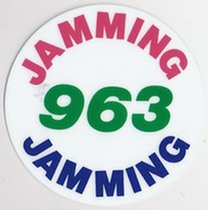© 2014-


Radio Caroline 1980s - History (4)
1985
Repeated transmitter and generator breakdowns as well as storm damage to the aerial system caused both stations on the Ross Revenge to leave the air for various periods during December 1984 and January 1985. On 6th January 1985, in Force 10 gales, the Ross Revenge dragged her anchor for about two miles and transmissions had to be terminated while emergency services were alerted. Regular programmes on both stations were eventually resumed on 11th January 1985.
On land official dissatisfaction with the operation of the two offshore radio ships continued. The British authorities intercepted what they thought was a tender from the Ross Revenge in March 1985, but it transpired that it was one of the sightseeing boat trips to the Ross Revenge and Communicator.
In April 1985 the British Association of Independent Radio Contractors (AIRC) sent an internal memo to all their members requesting information about people working for the two offshore radio stations, in particular Radio Caroline. At about the same time letters were also issued by the Department of Trade and Industry (DTI) to all companies who advertised on Laser 558 and Radio Caroline warning them that they faced prosecution under the Marine etc. Broadcasting (Offences) Act 1967 if their commercials continued to be broadcast.
Radio Caroline appointed American radio format specialist Lee Abrams in March 1985 as a consultant to advise on future programming style and on the sale of airtime. As a result Radio Caroline's programming changed gradually, becoming more inclined towards the Top 40 chart and going some way to meeting the intense challenge from Laser 558.
On 1st May 1985 Radio Caroline's overnight programmes did not start on 963kHz immediately after Radio Monique's transmissions had ended. Instead an hour of non-
On 5th June 1985 the Vancouver Sun newspaper carried an article explaining the Expo 86 promotions on Radio Caroline and also gave the first real insight into Canadian financial backing for the station. The investment package which led to the re-
A former employee of Skalbania, John Chambers, was now selling airtime in Canada on behalf of Radio Caroline and he approached the Expo organisation. Expo obtained approval to use Radio Caroline from their board of directors, who were aware that the offshore station operated outside British and most European law. However ,it was not illegal for a Canadian company or organisation to purchase airtime on the station. Vancouver advertising agency Baker Lovick produced the commercials and Barbara Jako of Expo's Advertising Department reported that a number of enquiries had been received from Europe in response to the commercials broadcast by Radio Caroline.
Any unsold airtim e between the closure of Radio Monique at 6.00pm and the link-
e between the closure of Radio Monique at 6.00pm and the link-
A sinister turn of events took place at the beginning of August 1985 affecting both radio ships anchored in the North Sea. During the evening of 8th August 1985 a helicopter circled over the Communicator with its searchlight trained o n the radio ship and the ocean going launch Dioptric Surveyor, which had been chartered by the British Department of Trade and Industry British Department of Trade and Industry (DTI), anchored nearby to keep watch on comings and goings in the vicinity of the Ross Revenge and the Communicator. Although no one knew at the time this was the start of what became known as "Eurosiege 85", a surveillance operation mounted by the DTI.
n the radio ship and the ocean going launch Dioptric Surveyor, which had been chartered by the British Department of Trade and Industry British Department of Trade and Industry (DTI), anchored nearby to keep watch on comings and goings in the vicinity of the Ross Revenge and the Communicator. Although no one knew at the time this was the start of what became known as "Eurosiege 85", a surveillance operation mounted by the DTI.
A DTI spokesman was quoted as saying "We will keep the Dioptric Surveyor on station in the Thames Estuary for the foreseeable future. We want Laser and Caroline off the air." A Radio Caroline spokesman condemned the blockade as "a massive waste of public money when all we do is provide a legal music service which is enjoyed by millions."
The DTI action in hiring the Dioptric Surveyor was generally accepted to have been taken as the result of pressure from the Independent Broadcasting Authority (IBA) and ILR commercial radio stations in Kent and Essex. These stations felt that they had to compete on unequal terms with the offshore broadcasters.
In an exercise to test the effectiveness of the blockade and establish whether public money was being wasted the Daily Star sent a reporter to deliver supplies, T-
In contrast to the high profile British action the Dutch authorities chose to pursue the offshore stations, particularly Radio Monique, behind the scenes. A spokesman for the Dutch Department of Justice in Amsterdam, Henk Wooldrik said:-
In mid-
In an effort to counter adverse publicity surrounding the surveillance operation (in particular criticisms of the enormous cost to taxpayers) and to explain why they wanted the offshore stations closed the DTI held a number of 'roadshow' meetings for representatives of the media during October 1985. The first meeting, at Maidstone on 16th October 1985, was chaired by Peter Anderson of the DTI's Press Office, also present were the DTI's Radio Investigation Service Director, Dilys Gane and Maurice Ricketts, Head of the Radio Investigation Services Technical Section.
Dilys Gane was reported as saying: “The pirate radio stations are putting out such power that they are jamming out both the frequencies they are using, obviously, and surrounding frequencies. We've had numerous complaints from helicopter pilots trying to land on oil rigs in the North Sea because their directional beacons are being jammed by the pirate ships and instead of getting the signals to help them land in those very dangerous conditions they're getting pop music”.

BBC TV news report about the start of ‘Euroseige’.
August 1985

Click on picture to enlarge
DTI surveillance vessel, Dioptric Surveyor
photo: Bob le Roi

The Times
14th August 1985
Expo 86



Seagull Sales




East Anglian Daily Times
7th January 1985

East Anglian Daily Times
29th March 1985

Daily Star
15th August 1985

History
Key Dates
Ship and Location
Technical
Staff
Programmes





Treasure Chest





Back to Britain Gallery


Back to Radio Caroline 1980s
